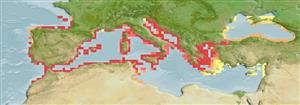Environment: milieu / climate zone / depth range / distribution range
Écologie
marin; saumâtre démersal. Subtropical; 46°N - 33°N, 10°W - 42°E
Eastern Atlantic: Atlantic coast from France to Morocco; also in the Mediterranean and Black seas and in the Suez Canal.
Taille / Poids / Âge
Maturity: Lm ? range ? - ? cm
Max length : 13.8 cm TL mâle / non sexé; (Ref. 118193)
Épines dorsales (Total): 11 - 13; Rayons mous dorsaux (Total): 225; Épines anales 2; Rayons mous anaux: 23 - 26. Diagnosis: Mature males with well-developed head-crest and anal gland in the first two anal-fin rays; sneaker males much smaller than nesting males and do not display male secondary sexual characters (Ref. 94108).
Facultative air-breathing (Ref. 126274); Adults occur in the intertidal zone and shallow bottoms, on rocks or sand between pebbles and vegetation (Ref. 5981). Often in brackish waters down to 5 ppt (Ref. 5981). Inhabit crevices or piddock holes, males remain in cavities above water-level during low tide (Ref. 5981). Feed on benthic invertebrates, mainly mollusks, also algae (Ref. 5981). Also ingest large amounts of aquatic insects and pupae (Ref. 94105). Oviparous (Ref. 205). Mature males adopt a passive role during courtship, rarely court females, do not defend nest territory, but provide parental care to eggs. Sneaker males assume a female-like behavior in order to approach the nests of nesting males and parasitically fertilize the eggs (Ref. 94113). Eggs are demersal and adhesive (Ref. 205). Has been reared in captivity (Ref. 35421).
Life cycle and mating behavior
Maturité | Reproduction | Frai | Œufs | Fécondité | Larves
Males court by nodding and undulating movements and drive females to spawning place by biting and butting (Ref. 5981) though this event is rarely done by the males, more or less adopting a passive role in the courtship (Ref 94113). Additionally, males don't defend a territory around the nest (Ref. 94113) though they guard eggs from several females (Ref. 5981, 94113).
Zander, C.D., 1986. Blenniidae. p. 1096-1112. In P.J.P. Whitehead, M.-L. Bauchot, J.-C. Hureau, J. Nielsen and E. Tortonese (eds.) Fishes of the North-eastern Atlantic and the Mediterranean, volume 3. UNESCO, Paris. (Ref. 5981)
Statut dans la liste rouge de l'IUCN (Ref. 130435)
Menace pour l'homme
Harmless
Utilisations par l'homme
Pêcheries: pêcheries vivrières
Plus d'informations
RéférencesAquacultureProfil d'aquacultureSouchesGénétiqueElectrophoresesHéritabilitéPathologiesTraitementNutrientsMass conversion
Outils
Articles particuliers
Télécharger en XML
Sources Internet
Estimates based on models
Preferred temperature (Ref.
123201): 15 - 21.2, mean 18.8 °C (based on 615 cells).
Phylogenetic diversity index (Ref.
82804): PD
50 = 0.5312 [Uniqueness, from 0.5 = low to 2.0 = high].
Bayesian length-weight: a=0.01072 (0.00842 - 0.01363), b=3.02 (2.95 - 3.09), in cm total length, based on LWR estimates for this species (Ref.
93245).
Niveau trophique (Ref.
69278): 3.6 ±0.0 se; based on diet studies.
Generation time: 2.2 ( na - na) years. Estimated as median ln(3)/K based on 1
growth studies.
Résilience (Ref.
120179): Haut, temps minimum de doublement de population inférieur à 15 mois (K=0.50).
Fishing Vulnerability (Ref.
59153): Low to moderate vulnerability (25 of 100).
Nutrients (Ref.
124155): Calcium = 127 [21, 405] mg/100g; Iron = 1.39 [0.52, 4.55] mg/100g; Protein = 4.16 [0.45, 7.88] %; Omega3 = 0.443 [0.183, 1.088] g/100g; Selenium = 8.2 [1.8, 25.0] μg/100g; VitaminA = 25.1 [8.9, 69.6] μg/100g; Zinc = 1.24 [0.59, 2.46] mg/100g (wet weight);
